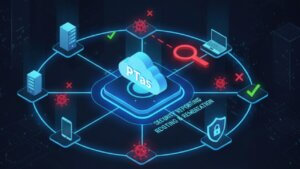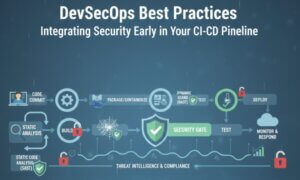As cyber threats grow more sophisticated, traditional security solutions often struggle to keep up with rapidly evolving malware techniques. Cloud-based malware sandboxes have emerged as a game-changer in cybersecurity, offering scalable, real-time malware analysis without compromising enterprise security infrastructure. This blog explores how cloud-based malware sandboxes work, their benefits, and their impact on modern cybersecurity.
Table of Contents
Understanding Cloud-Based Malware Sandboxes

A cloud-based malware sandbox is a remote, isolated environment designed to analyze, detect, and mitigate malware threats in real time. Unlike on-premise solutions, which require significant hardware and maintenance, cloud-based sandboxes leverage distributed computing resources, offering rapid scalability and enhanced threat intelligence.
How Cloud-Based Sandboxes Work
File Submission: Suspicious files, URLs, or scripts are uploaded to the sandbox.
Execution in an Isolated Environment: The sandbox executes the file in a controlled, cloud-hosted virtual environment.
Behavioral Analysis: The system monitors malware activities, such as file changes, registry modifications, and network communication.
Threat Detection & Classification: The sandbox applies AI-driven analytics, machine learning, and heuristic scanning to classify threats.
Automated Reporting & Threat Intelligence Sharing: Analysis results are shared with security tools like SIEMs, firewalls, and endpoint protection systems.
Key Benefits of Cloud-Based Malware Sandboxes

1. Scalability and Flexibility
Unlike traditional sandboxing solutions that require dedicated hardware, cloud-based sandboxes can dynamically scale to handle large volumes of malware samples simultaneously. This flexibility is crucial for enterprises and security operations centers (SOCs) managing high volumes of cyber threats.
2. Real-Time Malware Detection
Cloud-based sandboxes enable real-time threat detection, providing faster responses to emerging malware strains. As malware continuously evolves, rapid analysis and immediate response mechanisms help organizations mitigate attacks before they cause damage.
3. Reduced On-Premise Infrastructure Costs
On-premise sandboxing solutions require expensive hardware, ongoing maintenance, and dedicated IT personnel. By leveraging cloud infrastructure, organizations eliminate the costs associated with managing physical servers while still maintaining robust malware detection capabilities.
4. Integration with Threat Intelligence Platforms
Modern cloud sandboxes integrate seamlessly with global threat intelligence feeds, allowing security analysts to correlate malware behavior with existing threat databases. This enhances cyber threat hunting and improves defensive strategies against future attacks.
5. Advanced Evasion Detection
Many modern malware variants are designed to detect and evade traditional sandboxes. Cloud-based sandboxes leverage hypervisor-based monitoring, AI-driven behavioral analysis, and deception techniques to counteract evasion tactics used by sophisticated malware.
How Cloud-Based Sandboxes Are Impacting Cybersecurity
1. Strengthening Enterprise Security Posture
Enterprises are shifting towards cloud-native security solutions to safeguard their digital assets. Cloud-based sandboxes provide organizations with real-time threat visibility and proactive malware defense, reducing the risk of breaches and data leaks.
2. Enhancing Incident Response and Forensics
Incident response teams rely on malware sandboxes to perform forensic investigations. Cloud-based analysis accelerates forensic workflows by automating malware classification and providing detailed execution traces, aiding in faster remediation and mitigation of security incidents.
3. Combating Advanced Persistent Threats (APTs)
APT groups use highly evasive malware to infiltrate corporate networks and exfiltrate sensitive data. Cloud-based sandboxes help detect zero-day exploits, polymorphic malware, and advanced obfuscation techniques, enabling organizations to respond before an attack escalates.
4. Empowering Security Analysts with AI & Automation
Cloud-based malware sandboxes incorporate machine learning (ML) algorithms and AI-powered threat analytics, enabling analysts to detect and classify threats with high accuracy. Automation reduces manual workload, allowing cybersecurity professionals to focus on strategic threat mitigation.
Several leading cybersecurity vendors provide cloud-based malware sandboxing solutions, each offering unique capabilities:
1. Palo Alto Networks WildFire
AI-driven malware detection with automated response capabilities.
Integrated threat intelligence feeds for real-time updates.
Cloud-based behavioral analysis of files, URLs, and emails.
2. Cisco Threat Grid
Combines static and dynamic malware analysis.
Seamless integration with Cisco SecureX and other security tools.
Machine-learning algorithms to detect evasive malware.
3. FireEye Malware Analysis (AX Series)
Real-time malware analysis for enterprises and government agencies.
Multi-vector analysis for email, endpoint, and network-based threats.
Customizable sandbox environments for detailed forensic investigation.
4. VMRay Analyzer
Hypervisor-based monitoring for deep malware visibility.
API-driven automation for large-scale malware detection.
Advanced evasion resistance for detecting sophisticated threats.
5. CrowdStrike Falcon Sandbox
AI-powered malware classification and behavior analysis.
Integration with CrowdStrike’s endpoint detection and response (EDR) platform.
Cloud-based sandboxing for real-time incident response.
Challenges of Cloud-Based Malware Sandboxing
While cloud-based sandboxes offer numerous advantages, they also come with some challenges:
1. Privacy and Compliance Concerns
Uploading files to cloud-based sandboxes raises concerns about data confidentiality and compliance with regulations such as GDPR and HIPAA.
Organizations must ensure that malware samples do not contain sensitive corporate or customer data before uploading them to the cloud.
2. Malware Detection Evasion
Advanced malware may detect when it is running in a cloud-based sandbox and alter its execution to avoid detection.
To counteract this, vendors continuously enhance stealth techniques and behavioral analysis algorithms to detect evasive malware.
3. Internet Dependency and Latency
Cloud-based sandboxes require internet connectivity, which may introduce latency issues in real-time malware analysis.
Organizations with strict air-gapped security environments may need hybrid solutions that combine on-premise and cloud sandboxing.
The Future of Cloud-Based Malware Sandboxes
1. AI-Driven Threat Intelligence
Future cloud sandboxes will leverage advanced AI models to enhance threat detection, enabling automated correlation of malware behavior patterns across global networks.
2. Integration with Zero Trust Security Models
Cloud-based malware analysis will be a core component of zero trust architectures, providing real-time inspection of all incoming files and URLs before they reach endpoints.
3. Hybrid Cloud Sandboxing
Many organizations are adopting hybrid cloud security models, combining on-premise sandboxes with cloud-based analysis to balance security, performance, and compliance needs.
Conclusion
Cloud-based malware sandboxes are transforming the cybersecurity landscape by providing scalable, real-time, and AI-driven threat analysis. As malware threats evolve, leveraging cloud-based sandboxing solutions enhances an organization’s ability to detect, analyze, and respond to cyber threats proactively. While challenges exist, the benefits of cloud-based sandboxes far outweigh the risks, making them an essential tool for modern security operations. Moving forward, advancements in AI, automation, and hybrid cloud integration will further strengthen malware detection and response capabilities.
Why Businesses Trust SecureMyOrg for Comprehensive Network Security
At SecureMyOrg, we uncover and fix all possible security vulnerabilities of mobile and web, while providing solutions to mitigate risks. We are trusted by renowned companies like Yahoo, Gojek and Rippling, and with 100% client satisfaction, you’re in safe hands!







Some of the things people reach out to us for –
- Building their cybersecurity program from scratch – setting up cloud security using cost-effective tools, SIEM for alert monitoring, building policies for the company
- Vulnerability Assessment and Penetration Testing ( VAPT ) – We have certified professionals, with certifications like OSCP, CREST – CPSA & CRT, CKA and CKS
- DevSecOps consulting
- Red Teaming activity
- Regular security audits, before product release
- Full time security engineers.
Relevant Posts

What Is Penetration Testing as a Service?
Penetration testing as a service (PTaaS) lets experts simulate real attacks to uncover vulnerabilities before hackers do. This guide explains the process, benefits, and costs, helping businesses strengthen defenses with predictable, ongoing security checks.

How To Inspect Encrypted Traffic Without Breaking Privacy
Network administrators face a challenge: securing systems while respecting privacy. This guide explains how to inspect encrypted traffic without breaking privacy using metadata, anomaly detection, and machine learning ensuring visibility, compliance, and trust.

How to Audit Infrastructure as Code (IaC) for Security Vulnerabilities
Discover how to audit Infrastructure as Code (IaC) for security vulnerabilities with this practical guide. Learn to scan IaC files using tools like Checkov, fix issues like exposed resources, and integrate audits into CI/CD pipelines. Protect your cloud systems from misconfigurations and ensure compliance with clear, actionable steps.

DevSecOps Best Practices: Integrating Security Early in Your CI/CD Pipeline
This article provides a practical guide to embedding security into every stage of your CI/CD pipeline. Learn core DevSecOps best practices like SAST, DAST, dependency scanning, secrets management, and compliance automation to catch vulnerabilities early, foster a culture of shared ownership, and build a secure-by-design development process that accelerates release cycles.

5 Cloud Misconfigurations That Lead to Data Breaches
Cloud misconfigurations are one of the leading causes of data breaches, yet they’re also among the most preventable. From exposed storage buckets to weak IAM policies, attackers exploit these mistakes daily. Learn about the top 5 misconfigurations and how your organization can fix them before they lead to costly data exposure.

How Can Ethical Hacking Training Elevate Your Internal Cybersecurity?
Ethical hacking training empowers organizations to strengthen internal cybersecurity by uncovering vulnerabilities before attackers do. From mastering penetration testing to enhancing incident response, this training builds a proactive security culture. Learn how Secure My ORG’s programs can elevate your team’s skills and fortify defenses against modern threats like AI-driven attacks.
